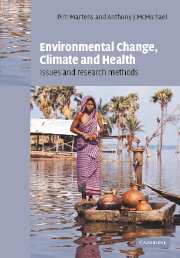Book contents
- Frontmatter
- Contents
- List of contributors
- Foreword
- 1 Global environmental changes: anticipating and assessing risks to health
- 2 Historical connections between climate, medical thought and human health
- 3 The contribution of global environmental factors to ill-health
- 4 Surprise, nonlinearity and complex behaviour
- 5 Epidemiological and impacts assessment methods
- 6 Retrospective studies: analogue approaches to describing climate variability and health
- 7 Detecting the infectious disease consequences of climate change and extreme weather events
- 8 Integrated Assessment modelling of human health impacts
- 9 Remote sensing, GIS and spatial statistics: powerful tools for landscape epidemiology
- 10 Monitoring the health impacts of global climate change
- 11 Epidemiology, environmental health and global change
- 12 Dealing with scientific uncertainties
- Index
- Plate section
- References
8 - Integrated Assessment modelling of human health impacts
Published online by Cambridge University Press: 28 July 2009
- Frontmatter
- Contents
- List of contributors
- Foreword
- 1 Global environmental changes: anticipating and assessing risks to health
- 2 Historical connections between climate, medical thought and human health
- 3 The contribution of global environmental factors to ill-health
- 4 Surprise, nonlinearity and complex behaviour
- 5 Epidemiological and impacts assessment methods
- 6 Retrospective studies: analogue approaches to describing climate variability and health
- 7 Detecting the infectious disease consequences of climate change and extreme weather events
- 8 Integrated Assessment modelling of human health impacts
- 9 Remote sensing, GIS and spatial statistics: powerful tools for landscape epidemiology
- 10 Monitoring the health impacts of global climate change
- 11 Epidemiology, environmental health and global change
- 12 Dealing with scientific uncertainties
- Index
- Plate section
- References
Summary
Introduction
Although mathematical modelling is often used by epidemiologists – to gain insights into the observed dynamics of infectious disease epidemics, for example, or to estimate future time trends in diseases – the complex task of estimating future trends and outcomes in relation to global atmospheric change and human health requires the use of integrated, systems-based mathematical models (McMichael & Martens, 1995). Looking at the complexity of the interactions between global (environmental) changes and human health, we need an integrated approach to ensure that key interactions, feedbacks and effects are not inadvertently omitted from the analysis. The various pieces of this complex puzzle can no longer be examined in isolation. Integrated Assessment (IA) aims to fit the pieces of the puzzle together, thereby indicating priorities for policy.
There is increasing recognition and credibility for the rapidly evolving field of IA. Within the setting of the political arena, it is accepted that IA can be supportive in the long-term policy-planning process, while in the scientific community more and more scientists realize the complementary value of IA research.
At present modelling is the dominant method of performing IA, including looking at global-change impacts on human health. However, many studies that are either explicitly or implicitly integrated assessments are still qualitative in nature, without using any models. Furthermore, the complexity of the issues addressed and the value-laden character of assessment activities make it impossible to address this process using only one approach.
- Type
- Chapter
- Information
- Environmental Change, Climate and HealthIssues and Research Methods, pp. 197 - 225Publisher: Cambridge University PressPrint publication year: 2002
References
- 3
- Cited by



